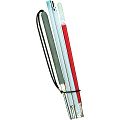
A blind cane, also known as a White Cane, is a lightweight and sturdy rod-like cane specifically developed for visually impaired or blind individuals as a mobility tool to assist them in safely navigating their path. A blind cane, while warning the user of obstacles such as stairs, curbs, and uneven terrain, also alerts others in the vicinity that the cane user has difficulty seeing.
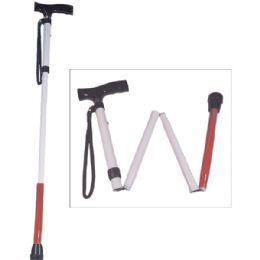
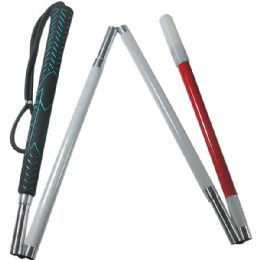
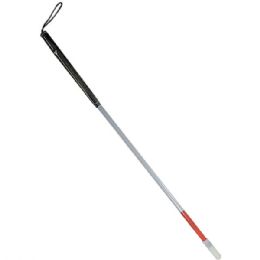
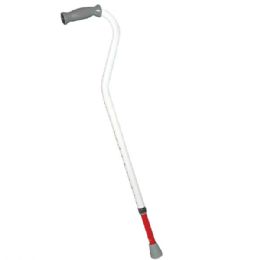
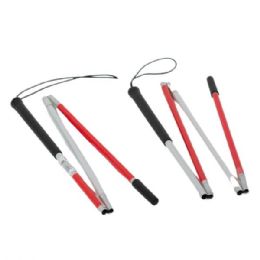
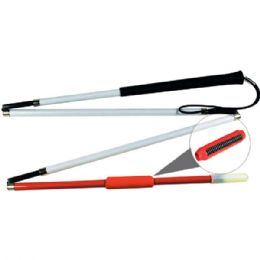
The white cane was specifically developed for people who are blind or visually impaired as a mobility tool and a safety measure for reliable navigation. These canes warn users that obstacles are in their path such as stairs and curbs, while they are also employed for determining traffic situations in crossing a street, alerting others in the vicinity that the cane user has some visual challenges.
How Do People Use a White Cane to Travel?
To accomplish tasks such as navigating escalators, going up and down stairs, finding doorways, feeling for curbs or uneven pavement and many other mobility applications, visually impaired individuals start by holding the cane at the level of their waist in whatever hand is most comfortable. Holding the cane by the handle and with their index finger pointed along the cane shaft, pointing toward the cane tip that is resting on the ground, users will sweep the cane side to side in an arch about the width of their body, with the cane tip touching the ground at the end of each sweep. This sequence allows the cane to tap the spot where the user’s next foot will land, allowing them to check for objects in their path before each step. If there is an object or a hole in the path, the cane will encounter it first, preventing a fall or stumble.
Will One Cane Fit All?
No. There are several different types or sizes of canes for the individual’s preferred taste, but the basic measurement for a white cane is that it should be long enough that it comes up to the user’s arm-pit or sternum with the tip resting on the floor. This size will allow the tip of the cane to land on the proper stepping spot when walking.
How are White Canes Constructed?
Due to the necessity of using a white cane with one hand while constantly moving it back and forth while walking, white canes are usually made out of lightweight and durable materials such as aircraft aluminum, fiberglass, and graphite.
What Are the Different Types of White Canes?
White canes usually come in two basic types; a straight cane and a folding cane. The National Federation of the Blind states that the greater length and lightness of a straight cane can allow for greater safety and mobility, whereas a collapsible cane can be easily collapsed and stored away for travel, giving more advantage in crowded areas such as business meetings, movie theaters, and classrooms. While they are great for transport, folding canes can tend to be less sturdy, become more prone to wear-and-tear, and may not provide the same type or amount of navigational feedback as a straight cane.
Long Cane - A traditional type of white cane, the long cane, also known as a probing cane, is primarily used as a mobility tool to detect objects in the user’s path. The cane length depends on the size of the user, and the cane should extend from the floor to the sternum. A long cane can either be a solid straight cane or a folding cane.
Guide Cane - A shorter cane than the long cane, extending generally from the floor to the user’s waist. This cane will have a more limited mobility function and is primarily used to scan for steps and curbs. It is also swept diagonally across the user’s body for protection in warning the user of obstacles that are placed immediately ahead.
Identification Cane - Often lighter and shorter than the long cane and not used as a mobility tool, the ID cane is only used to alert others of the user’s visual impairment.
Green Cane - In some countries, a green cane will designate the user has low vision or is vision impaired, while a white cane signifies the user is blind.
Kiddie Cane – This is the same as an adult sized long cane but is specifically sized and designed for usage by children.
What Are the Different Types of Cane Tips?
Cane tips come in a variety of shapes and sizes for different circumstances and situations. The primary purpose of a cane tip is to protect the end of the cane shaft and is designed for use or travel on city streets, and for a rougher surface such as roads, dirt paths and grassy surfaces. They also help protect the cane shaft wherever the user may utilize the cane, such as indoor walking surfaces.
Rolling Ball Tip - This cane tip is usually about the size of a small apple and is designed for easier maneuvering along sidewalks because it rolls over cracks in the sidewalk, providing a smoother walking experience. It also adds more weight to the cane which may contribute to wrist fatigue, and might not provide the user as much feedback about slight or small changes in the environment.
Pencil Tip – The Pencil tip is lighter and is a better fit for people who may have wrist problems or weakness. While it usually highlights a long lasting nylon tip, this thinner tip does have a tendency to get stuck in sidewalk cracks and uneven surfaces.
Metal Glide Tip – This tip is very light and will glide more easily over sidewalk cracks, will last longer than a nylon tip, and will give good feedback about surface changes.
Marshmallow Tip – Usually formulated with durable nylon, this tip won’t easily get stuck in sidewalk cracks. But, it can be heavy, possibly causing wrist fatigue when used for longer lengths of time.
Pointer Tip – Traditionally used with a guide cane, the pointer tip is like a finger on the end of the cane and is repeatedly tapped over the ground. Because the usage is tapping and not sweeping, it tends to give less information about the upcoming terrain.
Ceramic Tip – Offers excellent audio feedback for users, but may not be very durable over time.
Rehabmart is pleased to carry white canes for visually impaired individuals from the top quality vendor, MaxiAids.
Hulet Smith, OT
Rehabmart Co-Founder & CEO
ws